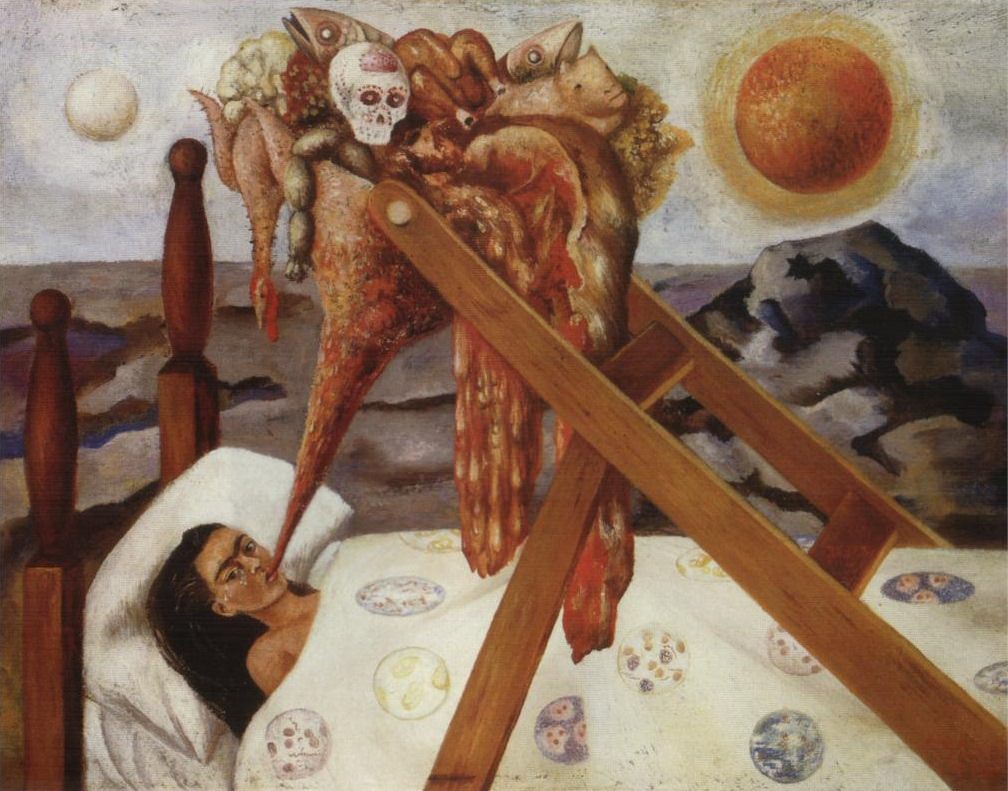
Frida Kahlo and her Body of Radical Works
Written by Rati Agnihotri
Frida Kahlo’s work resonates with a Surrealism that is paradoxically borne out of her very tragic private reality. The principal initiator of Surrealism in Art Andre Breton described her as a Surrealist, a title that Kahlo rejected saying, “I never painted dreams. I painted my own reality”. For someone who had met with a gruesome traffic accident in her teenage years and underwent about 30 operations in her lifetime, reality must have been indeed very different from that of a person leading a normal course of life. And it is this intense, ‘out of everyday’ reality that Frida explored through works with hyperbolic imagery that bordered on the grotesque.
Frida’s experience with pain during her lifetime, both intense physical and emotional pain seems to characterize a lot of her work. Her self-portraits are often an exploration of the self through a range of mythic symbols drawn from the indigenous Mexican culture. What one often finds in Frida’s work is a gut wrenching depiction of the anatomy of the female body. The female body in her portraits is often disembodied, fragmented and distorted, something that then becomes a symbol of the disenfranchised female subjectivity, the broken female psyche as it were.
In ‘The Broken Column’ ( 1944 ), a self-portrait, Kahlo depicts herself bound and constrained by a cage like body brace. A cavern of missing flesh violates the integrity of her body, exposing a broken column in place of her spine. Her face, her breasts, arms and torso, all are pierced by metal nails. Kahlo makes herself a subject of intense public scrutiny by placing her apparatus like body and face, in its precise geometrical, 3D like texture and expression against the backdrop of a barren landscape. And this is where the surrealism comes in. The tears streaming down her eyes in the self-portrait stand in stark contrast to the visual of the injured body, the portrayal of which in a broken machine like fashion accentuate the pain and the intensity of emotion the portrait embodies. The Broken Column was painted immediately after Kahlo underwent spinal surgery. Many critics see the portrait as a direct expression of her traumatized state of mind after undergoing the operation.

‘Without Hope’ is yet another strong work that Kahlo painted in 1945 when she was undergoing several sicknesses and had literally lost all hope in relation to living. The painting is very intense and grotesque in its depiction of a sick Frida on what seems like a death bed being force fed through a funnel being held by a wooden canvas. The use of strong reds heightens the sense of blood, death and despair that one gets while viewing the painting. The death bed in the middle of a surrealist landscape, the image of the skull, the painting canvas and the rather macabre imagery on the canvas in what seems like a lump of flesh, all make the object of the painting self-reflexive. It seems like Frida the painter, paints herself (the object) in a dynamic setting in which the viewer can visualize her as an object, assuming the role of a subject , making the viewer conscious of her emotional turbulence through that deep, penetrating gaze of an agency.

Frida’s tumultuous relationship with her partner Diego Rivera (the famous Mexican muralist), 20 years her senior, whom she married when she was 22, influenced many of her works. Their stormy, passionate relationship survived infidelities, the pressure of career, divorce, remarriage, Frida’s bisexual affairs, her poor health and her inability to have children.
‘The Two Fridas’ (1939) portrays Frida’s identity crisis, the tussle between her Mexican roots and the European aspect of her persona. The work also explores the chaos and melancholy of her bit by bit disintegrating relationship with Diego Rivera. The two portraits of Frida,the one on the right being the Frida in a Mexican costume and the one on the left being the European Frida, seem to be holding hands but the look on their respective faces is one of doubt and perhaps pathos. The symbolic hearts make the work surreal, wherein the heart of the Mexican Frida is full and wholesome, indicating, critics say that she is loved and respected by her partner Diego. On the contrary, the heart of the European Frida is fractured indicating the fissure in the relationship. The dramatic backdrop of an element of nature is a trope that runs concurrent in a number of Frida Kahlo’s works.

Unlike many other surrealists whose work springs from out of the ordinary and the bizarre, Frida Kahlo’s work sincerely follow her life trajectory. What makes these surreal is Kahlo’s extraordinary sensibility in laying bare the pain and pathos inherent in various episodes of her life. Works like Self-Portrait with Bead Necklace ( 1933 ), Self Portrait with Curly Hair ( 1934 ) , Me and My Doll ( 1937 ), My Wet Nurse and I ( 1937 ) are all Frida’s exploration of her self and also reflect her desire to return to her native Mexican roots and her anxiety at finding herself a misfit in a modern, industrial society.
It would be perhaps apt to conclude with the mention of the only painting in Frida’s oeuvre that is a collage – ‘My Dress Hangs There’ (1933). In this painting, the only symbol of Frida is a native Mexican dress hanging in the middle. The dress is surrounded by various symbols of a modern, capitalist society. These symbols – the telephone, the toilet bowl, the sports trophy all have been use by Frida to mock the degenerated and dissipated state of American industrial society. Frida completed this work during her stay in New York with Diego Rivera.

